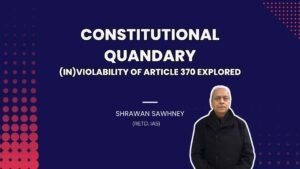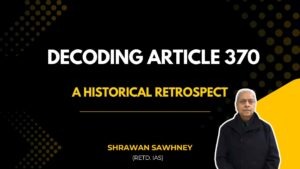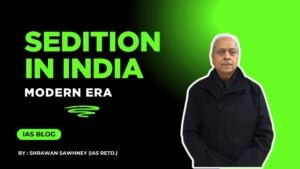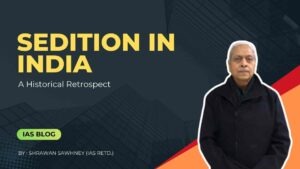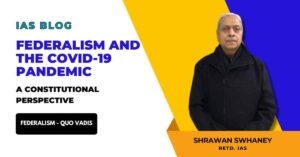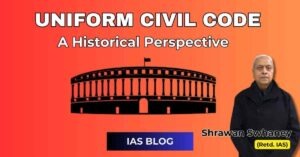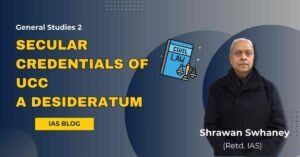Uniform Civil Code - A Historical Perspective
Uniform Civil Code - A Historical Perspective
Should India have a Uniform Civil Code (hereinafter referred to as UCC in short), a set of religion and gender neutral common family laws on marriage, separation, adoption, inheritance and so on?
This poser was keenly debated by the Constituent Assembly of India in the twilight of nascent republic.
Article 35 of the draft Constitution of India provided that “the State shall endeavour to secure for the citizens a uniform civil code throughout the territory of India.”
The Constituent Assembly took up Draft Article 35 for debate on 23rd November, 1948.
Progressive as well as conservative views were expressed as on the floor of the Constituent Assembly. The debate on this Draft Article triggered conflict in the Constituent Assembly. Muslim members opposed the Draft Article and proposed amendments to keep personal laws out of Draft Article’s scope.
Mr Mohamad Ismail Sahib (Madras) proposed a proviso as an amendment to the following effect:
“Provided that any group, section or community of peo ple shall not be obliged to give up its own personal law in case it has such a low.“
Mr Naziruddin Ahmad proposed that the following proviso be added to draft Article 35:
“Provided that the personal law of any community which has been guaranteed by the statute shall not be changed except with the previous approval of the community as certained in such manner as the Union Legislature may determine by law.“
Mahbood Ali Baig Sahib Bahadur moved that the following proviso be added to article 35:
“Provided that nothing in this articleshall affect the per- sonal law of the citizen.”
B Pocker Sahib Bahadur (Madras) supported the motion moved by Mr. Mohamed Ismail Sahib to the effect that the following proviso be added to article 35:
“Provided that any group, section or community of people shall not be obliged to give up its own personal law in case it has such a law.“
Hussain Imam (Bihar) felt that “it would be all right and a very desirable thing to have a uniform law, but at a very distant date. For that, the country should first await the coming of that event when the whole of India has got edu cated…..when their economic conditions are better, when each man is able to stand on his own legs….“
All Muslim members pleaded that the Draft Article be enforced only with the prior assent of their community. Their arguments were
a) that UCC violated freedom of religion;
b) The draft Article would create disharmony and
c) it was wrong to interfere with personal laws without the approval of religious communities.
It was argued that the right to adhere to one’s own personal laws was one of the fundamental rights and that personal laws were part and parcel of religion and culture. They emphasized that UCC should not include family law and inheritance.
KM Munshi expressed that “it must also be remembered that if this clause is not put in, it does not mean that the Parliament in future would have no right to enact a Civil Code.”
He felt that article guaranteeing religious freedom gave state the power to regulate secular activities associated with religion.
He further expressed that certain communities amongst Muslims, for example, Khojas and Cutchi Memons, did not want to follow the Shariat, but they were forced to do so under the Shariat Act, 1937.
He further propounded that European countries had uniform laws applied even to minorities and that religion should be divorced from personal laws.
He said for Hindus, too, personal laws were not uniform, there was the law of Mayukha applied in some parts of India, Mithakshara in others; and the law of Dayabhaga in Bengal.
He further said –
“there is one important consideration which we have to bear in mind and I want my Muslim friends to realise this that the sooner we forget this isolationist outlook on life, it will be better for the country. Religion must be restricted to spheres which legitimately appertain to religion, and the rest of life must be regulated, unified and modified in such a manner that we may evolve, as early as possible a strong and consolidated nation.“
Alladi Krishnaswam Ayyar expressed that “the objection was that religion was in danger, that communities can not live in amity if there is to be a uniform civil code. The article actually aims at amity.“
Concluding the debate, Dr. BR Ambedkar did not accept the amendments and defended the right of the state to interfere in the personal laws of different communities. He mentioned that many civil laws, such as IPC, CrPC, CPC, transfer of property, negotiable instruments, law of contracts, etc., had already been made uniformly applicable to all. Besides, Muslims in North- West Frontier followed Hindu law of succession till 1937.
He cited example of Muslims of North Malabar following Marumakkathyam Hindu matriarchal law to stress that Muslim personal laws were not immutable. He concluded by saying that “it is perfectly possible that the future Parliament may make a provision …………that the Code shall apply only to those who make a declaration that they are prepared to be bound by it.“
Despite opposition, the Draft Article 35 (now Article 44) found support of the majority of members who argued that the UCC was important to bolster the unity and integrity of the country. The argument that UCC would violate religious freedom was rejected and the Constituent Assembly paved the way for this social reform legislation to strengthen secularist and nationalist fabric of the country.
By: Shrawan Sawhney (IAS Retd.)
The Views expressed by the author are personal.
Notes on "Uniform Civil Code - A Historical Perspective"
Introduction
The Uniform Civil Code (UCC) refers to a common set of laws governing personal matters such as marriage, divorce, adoption, and inheritance, applicable to all citizens irrespective of religion or gender. The debate over UCC dates back to the framing of the Indian Constitution and continues to be a significant issue in contemporary India.
Constitutional Debate on UCC
Article 35 of the draft Constitution (now Article 44) stated:
“The State shall endeavour to secure for the citizens a uniform civil code throughout the territory of India.”
The debate on this provision in the Constituent Assembly on 23rd November 1948 revealed deep divisions, particularly along religious lines.
Opposition to UCC
Several Muslim members opposed the Draft Article 35, arguing that:
Violation of Religious Freedom: UCC would infringe upon the right to freedom of religion.
Threat to Communal Harmony: Imposing a uniform code might lead to social unrest.
Preservation of Personal Laws: Personal laws were intrinsic to religious identity and culture.
Proposed Amendments
Several amendments were suggested to restrict or modify the application of UCC:
Mr. Mohamad Ismail Sahib (Madras) proposed that no community should be forced to give up its personal law.
Mr. Naziruddin Ahmad suggested that any change to personal laws should require prior approval from the concerned community.
Mahbood Ali Baig Sahib Bahadur and B. Pocker Sahib Bahadur also advocated for a proviso ensuring the protection of personal laws.
Hussain Imam (Bihar) argued that UCC should be considered only when the country attained higher literacy and economic progress.
Support for UCC
Despite opposition, several members supported the enactment of UCC as a progressive legal reform:
K.M. Munshi asserted that:
Parliament would have the power to enact a Civil Code in the future.
Secular activities associated with religion could be regulated by the state.
Even within Hindu law, different schools of thought existed (Mayukha, Mitakshara, Dayabhaga), indicating the feasibility of legal unification.
European nations had successfully implemented uniform civil laws irrespective of religious identity.
Alladi Krishnaswami Ayyar emphasized that UCC aimed to promote national unity and communal amity.
Dr. B.R. Ambedkar defended the state’s right to intervene in personal laws, highlighting:
Various civil laws (IPC, CrPC, CPC, etc.) were already uniformly applicable across religions.
Historical examples where Muslims followed Hindu laws of succession (e.g., North-West Frontier Province until 1937).
The need for legal evolution to strengthen secularism and national integration.
Conclusion
Despite resistance, the Constituent Assembly upheld Draft Article 35 (now Article 44) as part of the Directive Principles of State Policy, envisioning UCC as a future reform for national unity and social progress. The debate underscored the tension between religious autonomy and legal uniformity, a discourse that continues in contemporary India.
Relevance for UPSC Aspirants
Prelims: Questions may be framed on Article 44, key debates, and personalities involved.
Mains (GS-II & Essay): UCC remains a significant topic under “Indian Constitution,” “Secularism,” and “Reforms in Personal Laws.” A well-balanced answer should cover historical debates, contemporary challenges, and potential solutions for UCC implementation.
Questions based on "Uniform Civil Code - A Historical Perspective"
1. Discuss the historical debates surrounding the Uniform Civil Code (UCC) in India. How did the Constituent Assembly address the concerns related to UCC? (GS-II: Indian Polity & Governance)
Answer Framework:
- Introduction: Define UCC and mention its origin in Article 44 of the Indian Constitution.
- Debate in the Constituent Assembly:
- Arguments against UCC (religious freedom, communal harmony, personal laws).
- Arguments for UCC (national integration, legal uniformity, social reform).
- Key Personalities and their Views:
- Opposition: Mohamad Ismail Sahib, Naziruddin Ahmad, Mahboob Ali Baig Sahib Bahadur.
- Support: K.M. Munshi, Alladi Krishnaswami Ayyar, Dr. B.R. Ambedkar.
- Conclusion: Mention that UCC remains a Directive Principle of State Policy, requiring gradual implementation.
2. The Uniform Civil Code is often seen as a conflict between religious freedom and gender justice. Examine this statement with suitable examples. (GS-II: Governance & Social Justice)
Answer Framework:
- Introduction: Define UCC and its constitutional basis (Article 44 vs. Article 25).
- Conflict Between Religious Freedom & Gender Justice:
- Personal laws often discriminate against women (e.g., triple talaq, polygamy, inheritance laws).
- Case studies: Shah Bano Case (1985), Shayara Bano Case (2017).
- Arguments in Favor of UCC:
- Ensures equality before law (Article 14).
- Promotes gender justice in marriage, divorce, and inheritance.
- Challenges in Implementation:
- Religious resistance, political sensitivity, lack of consensus.
- Conclusion: Need for gradual reforms while respecting diversity.
3. Analyze the challenges and prospects of implementing the Uniform Civil Code in India. Suggest a way forward. (GS-II: Indian Constitution & Governance)
Answer Framework:
- Introduction: Mention the constitutional directive under Article 44.
- Challenges in Implementation:
- Religious diversity and opposition.
- Socio-political sensitivities.
- Legal complexities (conflict with personal laws).
- Prospects of UCC:
- Example of Goa’s common civil code.
- Strengthening national unity and legal equality.
- Way Forward:
- Gradual implementation through voluntary adoption.
- Reforming personal laws first.
- Nationwide awareness campaigns.
- Conclusion: A balanced approach respecting religious sentiments while ensuring justice.
Questions based on "Uniform Civil Code - A Historical Perspective"
Prelims Questions based on UCC
Key Terms in Uniform Civil Code - A Historical Perspective
1. Mayukha
- Mayukha is an important legal text in Hindu law, specifically in the context of the Bombay School of Hindu Law.
- It was written by Nilkantha Bhatta and is considered an authoritative commentary on inheritance, property rights, and religious customs.
- It played a significant role in shaping Hindu inheritance laws in Maharashtra, Gujarat, and Karnataka.
- The text follows the Mitakshara system but incorporates regional variations.
2. Mitakshara
- Mitakshara is one of the two major schools of Hindu law related to property and inheritance (the other being Dayabhaga).
- It was written by Vijnaneshwara in the 11th century as a commentary on the Yajnavalkya Smriti.
- It follows the principle of coparcenary, meaning that a son acquires an interest in ancestral property by birth.
- It was widely followed in most parts of India, including Uttar Pradesh, Bihar, Madhya Pradesh, Rajasthan, and parts of South India.
- Under Mitakshara law, property is joint family property by default, and partition can occur only when a coparcener demands it.
3. Dayabhaga
- Dayabhaga is the second major school of Hindu law, developed by Jimutavahana in Bengal.
- Unlike Mitakshara, Dayabhaga does not recognize the right of a son in ancestral property by birth.
- Property is inherited only after the father’s death, meaning that the father has full control over his property during his lifetime.
- This system was followed primarily in Bengal and Assam.
- It provided greater flexibility for a father to dispose of his property and was also considered more favorable to individual ownership.
4. Marumakkathayam Hindu Matriarchal Law
- Marumakkathayam was a matrilineal system of inheritance followed mainly by certain Hindu communities in Kerala (such as the Nairs, some Tulu-speaking communities, and certain royal families).
- In this system, property was inherited through the female line—from mother to daughter or through maternal uncles.
- The joint family was called a Taravad, where the eldest female was the head, and male members had limited property rights.
- The system was abolished by the Hindu Succession Act, 1956, which brought uniformity in Hindu inheritance laws.
-
Constitutional Quandary: Inviolability of Article 370 Explored
Upon adoption of the Constitution of India, the preamble proclaimed,... -
Decoding Article 370 – A Historical Retrospect
The Apex Court is currently hearing petitions disputing the amendment... -
Sedition In India-Modern Era
English inhabitants in India requested the then Indian rulers to... -
Sedition In India – A Historical Retrospect
Sedition is perhaps the very vaguest of all offences known... -
Contours of Free Speech
Recent a spate of cases against stand-up comics Munawar Faruqui,... -
Generation-Z And Clout Culture
Generation Z, also known as Gen Z-ers and Zoomers, is... -
Community Resources :An Equitable Landscape
Community Resources: An Equitable Landscape Table of Contents Blog - Community... -
Federalism and the Covid-19 Pandemic: A Constitutional Perspective
Recently, an article in a leading English national daily made... -
Uniform Civil Code – A Historical Perspective
Article 35 of the draft Constitution of India provided that... -
Secular Credentials Of UCC – Shrawan Sawhney
Recently, the 22nd Law Commission of India has set the...


